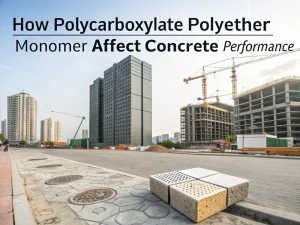Blog
Abstract: In modern concrete technology, polycarboxylate ether based superplasticizer, as the third generation and most advanced high-efficiency water reducer, PCE technology has become a standard configuration for high-performance concrete (HPC), self compacting concrete (SCC), and almost all cutting-edge construction projects.
But what exactly is it? What is the difference between it and traditional additives? Why does it have an overwhelming advantage in performance?
This guide will delve into polycarboxylate ether based superplasticizer, from its working principle to practical applications, providing you with a comprehensive answer.
Polycarboxylate ether based superplasticizer is a high range water reducer (HRWR) commonly known as polycarboxylate superplasticizer.
Its core function is to significantly reduce the amount of water required for mixing without affecting the workability of concrete; Alternatively, it can dramatically enhance the fluidity and workability of concrete without changing the water usage.
Unlike older generation additives such as lignosulfonates or naphthalene based products, PCE additives are synthesized from polycarboxylate ether polymers, which are complex molecules with unique skeletons and side chain structures that can be precisely designed according to specific performance requirements.
This molecular flexibility makes PCE admixtures superior in performance to traditional choices, making them an ideal choice for various high-strength, high workability concretes ranging from skyscrapers to prefabricated components.
The excellence of PCE additives lies in their unique and designable molecular structure, which is often metaphorically referred to as a “comb”.
When PCE is added to concrete, its working mechanism is as follows:
This spatial hindrance effect is the core of PCE technology. It is far more powerful and long-lasting than the electrostatic repulsion relied upon by the older generation of water reducing agents. The result is that the water trapped in the cement block is efficiently released, allowing the entire concrete mixture to achieve excellent fluidity even at extremely low water usage.
Choosing PCE technology means you will gain unparalleled advantages, including:
Its outstanding performance makes it an ideal choice for the following application scenarios:
High-performance concrete (HPC) and ultra-high-performance concrete (UHPC) are used to construct landmark buildings and infrastructure that require ultimate strength and durability.
Self-compacting concrete (SCC): Manufacturing concrete that can self-level and fill complex molds without any vibration.
Ready Mix Concrete: Ensure that the concrete still has perfect workability when it arrives at the construction site.
Precast Concrete: Improve production efficiency, improve surface smoothness of components, and enhance early strength.
3D printed concrete: providing the precise flowability and rapid prototyping performance required for this emerging technology.
Marine structures: resistant to seawater corrosion, extending the lifespan of ports, docks, and offshore platforms.
The admixture based on polycarboxylate ether (PCE) is not just another chemical additive; it is the cornerstone of modern concrete science. Through its unique molecular design and efficient steric hindrance effect, it solves the fundamental contradiction between strength and workability, making it possible to build more robust, durable, and challenging structures. PCE is undoubtedly the leading choice in any concrete application that pursues excellent performance.
What is the difference between PCE and naphthalene based additives?
PCE has a higher water reduction rate (30-40% vs. 15-20%), a more extended slump retention period, and better compatibility with green materials.
Can PCE admixture be used for all concrete mixtures?
Yes, but the dosage must be adjusted (0.5-3% of cement weight) – excessive dosage can cause segregation.
Will PCE additives affect the setting time?
According to project requirements, they can be designed to accelerate, delay, or have no impact on settings.
Is PCE additive environmentally friendly?
Yes, by reducing the use of cement and achieving green mixing (including fly ash/slag), they have lowered their carbon footprint.

How Polycarboxylate Polyether Monomer Affect Concrete Performance
Blog How Polycarboxylate

How Polycarboxylate Superplasticizer Interacts With Slag In Concrete
Blog How Polycarboxylate